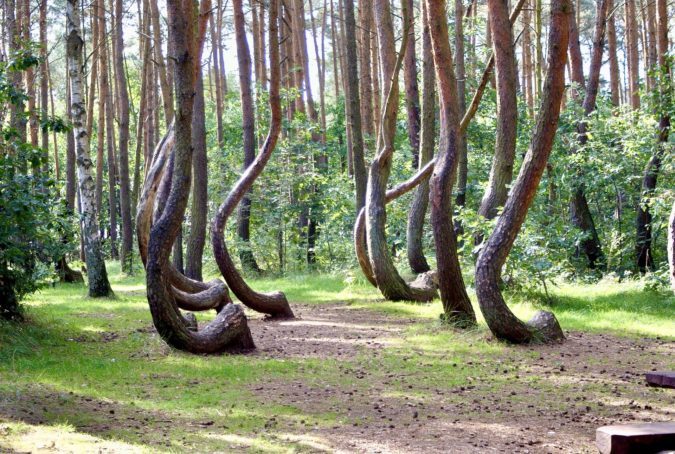Trees – come in all shapes and sizes

Trees come in many shapes and sizes. Some are tall and thin, like Poplars, others have a ‘rounded’ canopy, like oak and horse chestnut. Sometimes we ‘persuade’ trees to assume a particular shape or form, perhaps through pollarding or coppicing - or something more extreme - like topiary or bonsai. However, sometimes nature itself has unusual or dramatic effects on trees. Wind can leave trees on cliff tops or exposed places distorted and growing almost horizontally along the direction of the prevailing wind.
Occasionally, something very strange is seen. For example, at Gryfino in Western Poland, there is a forest with some very weird looking trees. There are about 400 trees that are bent at the base. At first, the trunk lies more or less parallel with the ground, then it bends upwards and the stem is erect. Consequently each trunk of these pines trees has a pronounced bend in it (see photo below).
 The rest of the trees in this forest are quite normal, growing upright and straight - like most pines.It is thought that the pines were planted back in the 1930’s though the local town was forsaken by the residents during the second world war (and only repopulated in relatively recent times). The trees are sometime referred to as the Crooked Forest. There has been much speculation as to how the trees came to be so mis-shapen. The theories run from
The rest of the trees in this forest are quite normal, growing upright and straight - like most pines.It is thought that the pines were planted back in the 1930’s though the local town was forsaken by the residents during the second world war (and only repopulated in relatively recent times). The trees are sometime referred to as the Crooked Forest. There has been much speculation as to how the trees came to be so mis-shapen. The theories run from
- The landing of alien space craft! This crushed / flattened the trees when young and tender
- The trees were damaged by German tanks during the war (but why only a select number of trees?)
- Genetic mutation(s) which resulted in abnormal growth
- Fungal infection(s) which resulted in abnormal growth
- The young trees were flattened by a heavy fall of snow, which perhaps persisted for some time. The trees were able to right themselves in the Spring, through a normal geotropic response.
- The trees were part of plantation / forest, in which some were deliberately cut at a young / sapling stage. The area was a tree farm, where some of the pines were cut / bent for later use in furniture or frames.
By bending a young tree down to the ground in this manner (for some time), compression wood is formed. Such wood has higher lignin and lower cellulose content and it is stronger than wood that is bent after a straight tree is felled (for example, by a steaming process). Indeed, English ‘hedgerow oak’ was known to be the best for the curved timbers needed to internally strengthen a sailing ship. Trees were even deliberately bent in certain ways so as to " grow" a required set of curved timbers. Such curved timbers were known as “compass timbers”. In Gryfino, it is likely that the war interrupted the activities of local foresters / woodworkers, they left and these trees were left to grow on in their rather unusual form.
Thanks to Kalasancjusz at Pixabay for the image of the crooked forest.
Comments are closed for this post.
